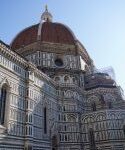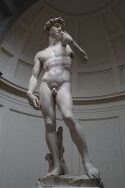August 22, 2017
With only one day, I had to plan carefully to get my ration of churches, forts, palaces—and here, Renaissance art museums.
I’m happy to say that, despite the challenges of being one among 22 million, I was reasonably successful.

 The morning began with a local guide taking us past the highlights: the Duomo, the Medici palaces (two of them), the ancient bridge (14th century) still used today. When the Medicis moved across the river, they changed the use of the bridge; previously it housed all kinds of vendors. The family objected to the smells of rotting meat, and so ordered the bridge to be used only by jewelers. “Gold smells good,” someone quipped.
The morning began with a local guide taking us past the highlights: the Duomo, the Medici palaces (two of them), the ancient bridge (14th century) still used today. When the Medicis moved across the river, they changed the use of the bridge; previously it housed all kinds of vendors. The family objected to the smells of rotting meat, and so ordered the bridge to be used only by jewelers. “Gold smells good,” someone quipped.
The tour took us past the religious center (the Duomo is larger than the one i n Siena, which it resembles in the white and green striped marble). The Duomo can accommodate 30,000 worshippers, but had a hard time accommodating the 30,000 tourists, who wanted to take advantage of one of the few free attractions in the city. It’s also the burial place of Michelangelo, who put Florence (and later the Vatican) on the art map. He’s standing in front of the town hall, or at least a copy of his famous statue of David is.
n Siena, which it resembles in the white and green striped marble). The Duomo can accommodate 30,000 worshippers, but had a hard time accommodating the 30,000 tourists, who wanted to take advantage of one of the few free attractions in the city. It’s also the burial place of Michelangelo, who put Florence (and later the Vatican) on the art map. He’s standing in front of the town hall, or at least a copy of his famous statue of David is.
 Our guide explained that the history of the Renaissance is largely tied up with the Medici family, which ruled Florence until the last family member died in the 1740s, and the area became part of the Duchy of Tuscany. The Medicis were sponsors of the arts, and Michelangelo lived in their palace and was schooled with their sons from the age of 9 until 17. Thereafter, he completed many projects (i.e., was paid) until the Medicis got too powerful and were overthrown briefly. He never made peace with the family, and went to Rome, where he spent 30 years painting the Sistine Chapel. The Medicis brought his body back, though, for a funeral in Florence.
Our guide explained that the history of the Renaissance is largely tied up with the Medici family, which ruled Florence until the last family member died in the 1740s, and the area became part of the Duchy of Tuscany. The Medicis were sponsors of the arts, and Michelangelo lived in their palace and was schooled with their sons from the age of 9 until 17. Thereafter, he completed many projects (i.e., was paid) until the Medicis got too powerful and were overthrown briefly. He never made peace with the family, and went to Rome, where he spent 30 years painting the Sistine Chapel. The Medicis brought his body back, though, for a funeral in Florence.

 With that background, I decided that with only one day, I would try to concentrate on the Medicis (who could resist Lorenzo the Magnificent?) and Michelangelo. I fear I scratched the surface, given the surfeit of palaces and works associated with two of Florence’s major citizens.
With that background, I decided that with only one day, I would try to concentrate on the Medicis (who could resist Lorenzo the Magnificent?) and Michelangelo. I fear I scratched the surface, given the surfeit of palaces and works associated with two of Florence’s major citizens.
 I went to the first (of three) Medici palaces, and realized that the family had good taste and funds. They were not nobles, but traded money for favors from royalty. One such trade brought them the right to use the fleur de lis (the Bourbon sign) which is now part of the logo for Florence (along with the iris, which is a legacy of the Roman founders;
I went to the first (of three) Medici palaces, and realized that the family had good taste and funds. They were not nobles, but traded money for favors from royalty. One such trade brought them the right to use the fleur de lis (the Bourbon sign) which is now part of the logo for Florence (along with the iris, which is a legacy of the Roman founders; Florence comes from flora). The other directly Medici buildings I saw came from their piety. They wanted to build a chapel and literally built a chapel and a church, both stunning works of art. The chapel has the family tombs. The church, named for St. Lawrence, was designed by Michelangelo, but when he broke with the family, he refused to finish the façade. The unfinished outside hides another stunning interior, with paintings from the Renaissance masters, and pulpits by the well-known sculptor, Donatello, who is buried in the crypt.
Florence comes from flora). The other directly Medici buildings I saw came from their piety. They wanted to build a chapel and literally built a chapel and a church, both stunning works of art. The chapel has the family tombs. The church, named for St. Lawrence, was designed by Michelangelo, but when he broke with the family, he refused to finish the façade. The unfinished outside hides another stunning interior, with paintings from the Renaissance masters, and pulpits by the well-known sculptor, Donatello, who is buried in the crypt.

 Carolyn insisted on seeing the real statue of David, not the copy that is in the square. That took us to the Academy, a building erected especially to house the statue (it’s about 20 feet tall), and is the most famous item in the building.
Carolyn insisted on seeing the real statue of David, not the copy that is in the square. That took us to the Academy, a building erected especially to house the statue (it’s about 20 feet tall), and is the most famous item in the building.

 That left the Uffizi, once the offices of the Medici government, now turned into one of the great art museums, based at least originally on the holdings of the family. Well-known paintings mostly from the Renaissance abound; there’s four rooms of Botticelli, for example. Two hours was almost enough to see just the highlights.
That left the Uffizi, once the offices of the Medici government, now turned into one of the great art museums, based at least originally on the holdings of the family. Well-known paintings mostly from the Renaissance abound; there’s four rooms of Botticelli, for example. Two hours was almost enough to see just the highlights.
Not a bad day’s sightseeing—for the last day of our Malta/Italy trip.